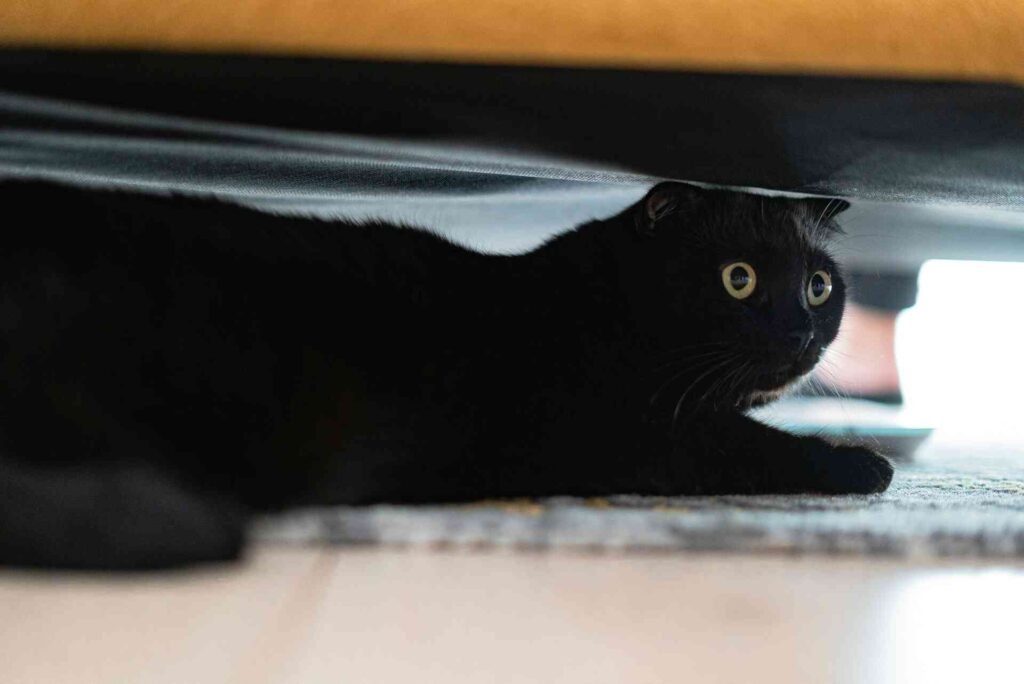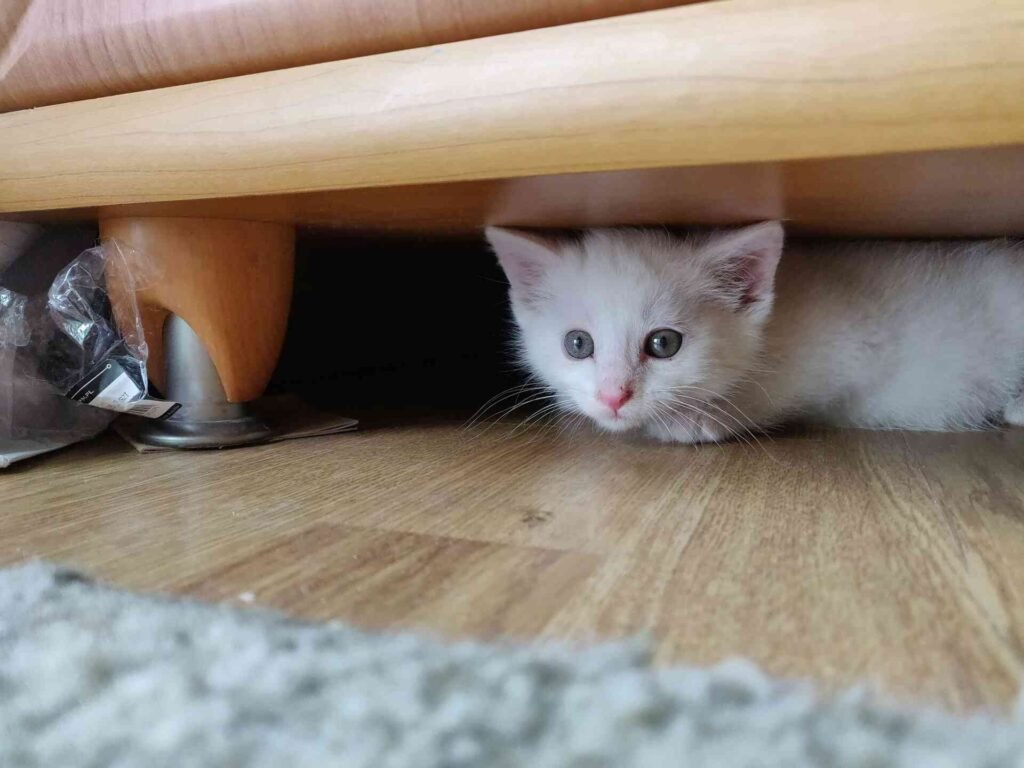Imagine this: you’re calling for Whiskers, treats in hand, only to spot two glowing eyes peering out from the dark recesses beneath your living room couch. If your cat hiding under the couch has become a daily occurrence, you’re not alone. Countless cat parents find themselves wondering why their feline friends have turned the space under furniture into their personal fortress.
Understanding this behavior isn’t just about satisfying curiosity, it’s about ensuring our cats feel safe, secure, and happy in their homes. Whether your kitty has always been a under-couch dweller or this is a new habit that’s got you concerned, we’re here to help you decode what’s really going on in that feline mind.

The Natural Instinct Behind the Hiding Game
Cats are naturally drawn to small, enclosed spaces, and it’s not just a quirky personality trait, it’s hardwired into their DNA. In the wild, finding secure hiding spots meant the difference between life and death. These cozy nooks provided protection from predators while offering the perfect vantage point to observe their surroundings.
Your modern house cat still carries these ancient instincts. That space under your couch mimics the perfect hiding spot: it’s dark, enclosed, and gives them a clear view of anyone approaching. From their perspective, they’ve found the ultimate safe room where they can retreat when the world feels overwhelming. The behavior becomes even more pronounced when cats experience stress or changes in their environment.
Common Reasons Why Cats Go Under the Couch
Understanding the root causes behind your cat’s hiding behavior is essential for addressing it effectively. Cats don’t hide without reason. There’s always an underlying motivation driving them to seek out that cozy under-couch sanctuary.
Stress and Anxiety Triggers
Life changes hit cats harder than many people realize. Moving to a new home, introducing new family members (human or pet), loud noises, or even rearranging furniture can send your cat scrambling for their under-couch sanctuary. They’re not being dramatic, they’re responding to what feels like a significant threat to their established routine.
Cats thrive on predictability, and when that predictability gets disrupted, hiding becomes their go-to coping mechanism. The familiar scent of their chosen hiding spot provides comfort during uncertain times.
Health Concerns That Drive Hiding Behavior
Sometimes, a cat hiding under the couch signals something more serious than environmental stress. Cats are masters at concealing illness and pain, often retreating to quiet spaces when they don’t feel well. If your typically social cat suddenly becomes a permanent under-couch resident, it’s worth scheduling a veterinary checkup.
Pain, nausea, or general malaise can make cats seek out spots where they feel protected and undisturbed. This instinctual behavior helped their ancestors recover from illness without attracting unwanted attention from predators.
Temperature and Comfort Preferences
Your couch might be sitting over the perfect climate-controlled zone in your home. Cats are particular about their comfort, and that space underneath furniture often maintains an ideal temperature: cooler in summer, warmer in winter, and consistently draft-free year-round.
The carpet or flooring beneath couches also tends to retain familiar scents, making it an appealing resting spot that smells like home and safety.
Territorial Behavior and Safe Space Creation
Multi-cat households often see more under-couch hiding as cats establish their individual territories. That space becomes their personal domain where they don’t have to share resources or worry about social conflicts with other pets.
Even in single-cat homes, claiming the under-couch territory gives cats a sense of ownership and control over their environment, something that’s crucial for their psychological well-being.
When to Be Concerned About the Hiding
While hiding is normal cat behavior, certain patterns should raise red flags. If your cat hiding under the couch is accompanied by changes in eating habits, litter box usage, or overall activity level, it’s time to take notice.
Sudden onset hiding in previously social cats, hiding that lasts for days without breaks for food or water, or hiding combined with visible distress signals like excessive vocalization or aggressive behavior when approached all warrant immediate attention.

Our article on cat sleeping positions can provide additional insights into your cat’s comfort level and stress indicators when combined with their hiding patterns.
How to Stop Your Cat From Going Under the Couch
Successfully redirecting your cat’s hiding behavior requires understanding that you’re not trying to eliminate their need for security, you’re simply offering better alternatives. The most effective approaches work with your cat’s natural instincts rather than against them.
Creating Alternative Safe Spaces
The key to reducing under-couch hiding isn’t forcing your cat out, it’s giving them better options. Set up designated safe spaces throughout your home that offer the same security benefits without the inconvenience of furniture-based hiding.
Cat caves, covered beds, or even cardboard boxes placed in quiet corners can become appealing alternatives. The trick is making these spaces more attractive than the under-couch real estate your cat currently prefers.
Our cat furniture placement guide can help you identify the best locations for these alternative hiding spots, ensuring they meet your cat’s natural preferences for security and observation points.
Physical Barriers and Furniture Modifications
If you need to block your cat from going under the couch for safety or cleanliness reasons, physical modifications work better than constant redirection. Furniture risers can eliminate the accessible space entirely, while decorative storage boxes or foam pool noodles can make the area less appealing without completely blocking airflow.
When implementing barriers, do so gradually and always provide alternative hiding options first. Suddenly cutting off access to a favored hiding spot without alternatives can increase anxiety and lead to inappropriate elimination or destructive behaviors.
Environmental Enrichment Solutions
Bored cats often become excessive hiders. Increasing environmental stimulation can reduce the appeal of spending all day under furniture. Interactive toys, puzzle feeders, and regular play sessions help cats expend energy in positive ways rather than retreating to hiding spots.
Window perches, cat trees, and climbing shelves provide elevated hiding options that satisfy the same security needs while keeping cats more engaged with their surroundings.
Getting Your Cat Out From Under the Couch
When your cat has claimed the under-couch territory, patience becomes your most valuable tool. Forcing the issue typically backfires, while gentle, consistent approaches yield much better results for both you and your feline friend.
The Right Approach vs. What Not to Do
Never try to forcibly remove a hiding cat by grabbing, pulling, or using tools to extract them. This approach destroys trust and can escalate their stress levels significantly. Instead, use patience and positive associations to encourage voluntary emergence.
Avoid making loud noises, moving furniture suddenly, or using spray bottles. These tactics often backfire by confirming that the world outside their hiding spot is indeed threatening.
Effective Coaxing Techniques
Food motivation works wonders for most cats. Place their favorite treats or a small portion of wet food at the edge of their hiding spot, gradually moving it further away over time. The key is patience, let them come to you rather than forcing interaction.
Quiet, calm conversation can also help. Sit nearby and speak softly, allowing your cat to become comfortable with your presence without feeling pressured to emerge immediately.
Building Trust and Reducing Fear
Consistency is crucial when helping anxious cats feel secure. Maintain regular feeding schedules, play sessions, and daily routines that help your cat predict what’s coming next. Predictability reduces anxiety and makes hiding less necessary.
Create positive associations with the main living areas by engaging in enjoyable activities like gentle grooming, interactive play, or simply sitting quietly together when your cat does venture out from under the couch.
Prevention Strategies for Long-term Success
The best approach to managing under-couch hiding is preventing it from becoming a problematic pattern in the first place. These strategies focus on creating an environment where your cat feels secure enough to choose open spaces over constant hiding.

Routine and Environmental Stability
Cats feel most secure when their environment remains consistent. While life changes are inevitable, minimizing unnecessary disruptions helps reduce hiding behaviors. When changes must occur, introduce them gradually whenever possible.
Stress Reduction Techniques
Creating a calm household atmosphere benefits everyone, not just your cat. Reduce loud noises when possible, maintain consistent daily schedules, and provide multiple resources (food bowls, water dishes, litter boxes) in different locations so your cat never feels trapped or cornered.
Pheromone diffusers, calming music designed for cats, and maintaining comfortable temperatures throughout your home all contribute to an environment where hiding becomes less necessary.
Health Monitoring and Regular Checkups
Regular veterinary visits help catch health issues before they become serious enough to drive excessive hiding behaviors. Monitor your cat’s normal patterns so you can quickly identify when hiding behavior changes from typical to concerning.
Different Types of Hiding Behavior
| Hiding Type | Duration | Triggers | Intervention Level |
|---|---|---|---|
| Normal Daily Hiding | 2-4 hours | Routine rest, temperature comfort | None needed |
| Stress-Related Hiding | 6-12 hours | Environmental changes, loud noises | Moderate – address stressors |
| Fear-Based Hiding | 12+ hours | New people, animals, major changes | High – gradual desensitization |
| Illness-Related Hiding | Continuous with brief breaks | Physical discomfort, pain | Immediate veterinary attention |
This comparison helps distinguish between normal behavior and situations requiring intervention.
Creating a Cat-Friendly Home Layout
The goal isn’t to eliminate all hiding spots, it’s to provide appropriate ones while maintaining access to important areas. Consider your home’s layout from your cat’s perspective. Are there enough elevated perches? Multiple escape routes? Quiet zones for retreating when needed?
Our article on why cats hide under blankets explores similar behaviors that indicate your cat’s preferences for enclosed, secure spaces, which can inform your approach to home modifications.
Frequently Asked Questions
Is it normal for cats to hide under the couch every day?
Daily hiding for short periods is completely normal, especially if your cat has established this as part of their routine. However, if the hiding increases dramatically or your cat stops coming out for meals, social interaction, or litter box use, it’s worth investigating potential stressors or health concerns.
How long should I let my cat stay under the couch?
Allow your cat to emerge naturally rather than setting arbitrary time limits. Most cats will come out when they feel ready, typically for food, water, or litter box needs. If your cat remains hidden for more than 24 hours without eating or drinking, consult your veterinarian.
Why does my cat suddenly start hiding?
Sudden changes in hiding behavior often indicate environmental stressors, health issues, or changes in routine. Consider recent changes in your home, new pets or people, seasonal shifts, or schedule modifications. If no obvious triggers exist, schedule a veterinary checkup to rule out health concerns.
Should I block access to prevent my cat from going under the couch?
Only block access if safety concerns exist (such as getting stuck or accessing dangerous areas). Always provide alternative hiding spots before removing access to preferred locations. Sudden elimination of safe spaces can increase anxiety and lead to behavioral problems.
Can hiding under the couch indicate my cat is sick?
Yes, increased hiding can signal illness or pain. Cats instinctively seek quiet, protected spaces when unwell. If hiding behavior changes suddenly, increases dramatically, or is accompanied by other symptoms like changes in appetite, elimination habits, or activity level, veterinary evaluation is recommended.
How can I make other areas more appealing than the couch?
Create alternative hiding spots using cat caves, covered beds, or cardboard boxes in quiet areas. Ensure these spaces offer similar benefits: security, good vantage points, and comfortable temperatures. Make them more appealing by placing favorite blankets, toys, or treats nearby.
Conclusion
Understanding why your cat keeps hiding under the couch opens the door to creating a more harmonious living situation for both of you. Remember that hiding is a natural, healthy behavior for cats. The key is ensuring it doesn’t become excessive or indicate underlying problems.
By providing appropriate alternatives, maintaining a stable environment, and respecting your cat’s need for security, you can help them feel confident enough to spend more time in the open while still having access to safe retreats when needed. Our article on pet myths includes common misconceptions about pet behavior that might be influencing your approach to this situation.
Every cat is unique, and what works for one may not work for another. Be patient, observe your cat’s individual preferences, and don’t hesitate to consult with your veterinarian or a feline behaviorist if concerns persist. With understanding and the right approach, you can help your cat feel secure and happy throughout your entire home, not just in the space beneath your furniture.
Looking for more? Explore our Cat Health section for more posts like this, visit the Blog for fun and insightful reads, or browse our full Cat Category for everything feline-related, from care to comfort.
Disclaimer: This article is for informational purposes only and does not substitute for professional veterinary advice. Always consult your veterinarian for diagnosis and treatment tailored to your cat’s individual needs. Please verify current product information directly on the retailer’s site before purchasing.
References
- Kry K, Casey R. The effect of hiding enrichment on stress levels and behaviour of domestic cats (Felis sylvestris catus) in a shelter setting and the implications for adoption potential. Animal Welfare. 2007;16(3):375-383. http://dx.doi.org/10.1017/S0962728600027196
- Vinke, Claudia & Godijn, L.M. & Leij, W.J.R.. (2014). Will a hiding box provide stress reduction for shelter cats?. Applied Animal Behaviour Science. 160. https://doi.org/10.1016/j.applanim.2014.09.002
Check out our most recent articles!
- Cats and Snow: Why Some Love It and Others Don’tSnow isn’t just uncomfortable for many cats, it’s a complete sensory overload. From cold paw pads to wet fur and changed landscapes, winter challenges feline comfort in unexpected ways. Learn how to recognize stress signals and create cozy alternatives for snow-averse cats.
- Christmas Names for Cats: From Classic to Creative Holiday IdeasNaming your holiday cat goes beyond festive fun. Discover why Christmas-inspired names age beautifully, spark instant connections with fellow pet lovers, and capture the warmth cats bring to our homes during the most magical season of the year.
- How to Keep Your Cat From Drinking Christmas Tree WaterYour cat’s obsession with Christmas tree water isn’t just annoying, it’s genuinely dangerous. From harmful bacteria to toxic additives, that festive reservoir poses real health risks. Discover practical solutions that protect your pet without sacrificing holiday cheer.
- Best Cat Toys for Christmas: The Ultimate Guide to Holiday JoyNot all Christmas gifts end up under the tree, some get batted across the floor at 3 AM. Explore the wonderful world of holiday cat toys that match your feline’s personality, from plush companions for cuddlers to high-tech options for the eternally energetic.
- Are Fake Christmas Trees Safe for Cats? A Holiday Safety GuideThat beautiful Christmas tree might look festive to you, but to your cat, it’s an irresistible climbing gym with built-in toys. Find out whether artificial trees are truly safer for cats and discover the hidden dangers lurking in your holiday decorations.
- The Best Christmas Gifts for Cats That’ll Actually Get Used (Not Ignored)Not all Christmas gifts land on the nice list with our feline friends. Discover which presents actually spark joy in cats and which ones end up gathering dust under the couch by New Year’s Day.
- Do Cats Eat Less in Winter? How Cold Weather Affects Your Cat’s AppetiteWinter brings more than just cold weather, it can completely change your cat’s eating habits. From bored indoor cats to outdoor ferals fighting to survive, discover what’s really driving those appetite changes and how to respond appropriately.
- Are Humidifiers Good for Cats? A Complete Safety & Health GuideNot all humidifiers are cat-safe, and some common practices could be toxic. Learn why cool mist beats warm mist, why essential oils are dangerous for felines, and how proper humidity levels between 30-50% support your cat’s breathing and coat health.
- How to Protect Leather Furniture From Cats (Without Losing Your Mind)Leather furniture and cat claws seem like natural enemies, but they don’t have to be. Learn why your cat is drawn to that expensive couch in the first place, and how simple redirects can save your furniture while keeping your cat’s natural behaviors satisfied.
- The Best Material for Cat Bowls: Protect Your Cat from BacteriaStainless steel, ceramic, or plastic, which material keeps your cat healthiest? We break down the science behind cat bowl materials, revealing why some harbor bacteria and others last decades without compromising your feline’s wellbeing.










